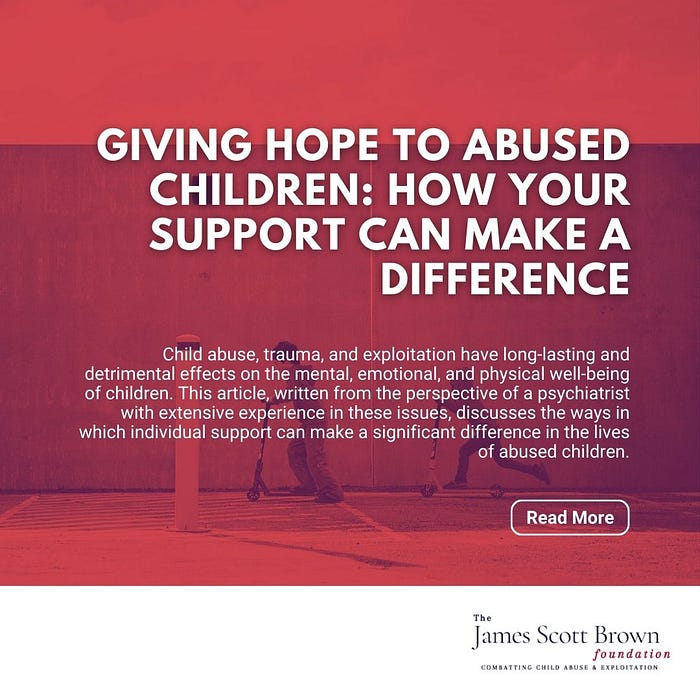Giving Hope to Abused Children: How Your Support Can Make a Difference by James Scott Brown Foundation
by James Scott Brown Foundation

Abstract:
Child abuse, trauma, and exploitation have long-lasting and detrimental effects on the mental, emotional, and physical well-being of children. This article, written from the perspective of a psychiatrist with extensive experience in these issues, discusses the ways in which individual support can make a significant difference in the lives of abused children. By actively participating in child welfare initiatives, one can provide hope and facilitate the healing process for these vulnerable young individuals.
1.Emotional Support and Active Listening:
Creating a safe and trusting environment for abused children to express their feelings is crucial for their recovery (Trickett et al., 2011). Active listening and empathic understanding can help these children feel heard, validated, and supported.
2. Access to Professional Services:
Ensure that abused children receive timely access to necessary professional services, such as therapy and counseling (Deblinger et al., 2006). These services can help children develop coping strategies, enhance resilience, and promote long-term healing.
3. Educational Support:
Assist in providing educational support to abused children, as trauma can severely impact their academic performance and future opportunities (Eckenrode et al., 1993). By facilitating access to tutoring, mentorship, or special education services, you can help these children overcome the challenges they face.
4. Support Groups:
Encourage participation in support groups that cater to the unique needs of abused children (Gilbert et al., 2009). These groups can provide a sense of belonging, understanding, and mutual encouragement, promoting healing and fostering a sense of empowerment.
5. Advocacy:
Actively advocate for the rights and well-being of abused children, both within your community and on a broader scale (Finkelhor, 2009). By raising awareness and lobbying for policy changes, you can contribute to creating a safer and more supportive environment for these children.
6. Financial Assistance:
Donate to organizations and initiatives that provide essential services to abused children and their families (Small, 2011). Financial contributions can help fund therapy, medical care, legal support, and educational resources, among other critical services.
7. Volunteer:
Offer your time and skills to organizations that work directly with abused children, such as crisis centers, shelters, and non-profit agencies (Deblinger et al., 2006). By volunteering, you can make a tangible difference in the lives of these children and help them on their path to recovery.
Conclusion:
Supporting abused children in their journey towards healing and resilience is a multifaceted process, involving emotional and educational support, access to professional services, participation in support groups, advocacy, financial assistance, and volunteering. By actively engaging in these efforts, you can provide hope and foster positive change for vulnerable children who have experienced abuse, trauma, or exploitation.
References:
Deblinger, E., Mannarino, A. P., Cohen, J. A., & Steer, R. A. (2006). A follow-up study of a multisite, randomized, controlled trial for children with sexual abuse-related PTSD symptoms. Journal of the American Academy of Child and Adolescent Psychiatry, 45(12), 1474–1484.
Eckenrode, J., Laird, M., & Doris, J. (1993). School performance and disciplinary problems among abused and neglected children. Developmental Psychology, 29(1), 53–62.
Finkelhor, D. (2009). The prevention of childhood sexual abuse. The Future of Children, 19(2), 169–194.
Gilbert, R., Widom, C. S., Browne, K., Fergusson, D., Webb, E., & Janson, S. (2009). Burden and consequences of child maltreatment in high-income countries. The Lancet, 373(9657), 68–81.
Small, M. A. (2011). Unanticipated gains: Origins of network inequality in everyday life. Oxford University Press.
Trickett, P. K., Noll, J. G., & Putnam, F. W. (2011). The impact of sexual abuse on female development: Lessons from a multigenerational, longitudinal research study. Development and Psychopathology, 23(2), 453–476.
Read more at the James Scott Brown Foundation.
Comments
Post a Comment